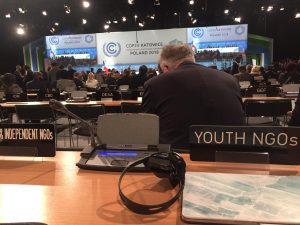
Indonesia Pavilion at COP24
Udit Gupta
In the face of a news-storm on commitments not materializing, the Green Climate Fund (GCF) puts up a brave face in its pavilion and side events. The panel discussion was fairly technical but well tailored for the audience, all of which were involved in some way with GCF.
On the other hand, Indian pavilion is the talk of the town. It has revolving robotic arms which showcases environment and forest policy. The Indonesian pavilion is a close second, while the United States is notably absent.
I also had the chance to meet with members of the Indian delegation, it was somewhat surprising to me how many Ministry of Finance and Ministry of Power officials negotiated for India.
Amanda Ullman
It was a day of Low Emissions Development Strategies (LEDS) for me at my first day of COP24. The Nationally Determined Contributions (NDC) Partnership kicked off my evening with a panel of representatives from Chile, Colombia, and India who each discussed their countries’ unique approach to LEDS and served as case studies for countries facing similar developmental environments. The success of the collaborative nature of the event was most evident during the question and answer portion. It was then that a representative from Mexico, who happened to be sitting in the audience, jumped in the conversation to offer his experience in the effectiveness of using federal law as a motivator for subnational government action.
Similar lessons were conveyed in a side event on National Engagement for Low Emission Development Pathways. In this discussion, we again received a comparative glance into strategies for Low Emission Development success, this time between Tunisia, India, South Africa, Ethiopia, and Madagascar. Some key takeaways were the attribution of Tunisia’s success to the incredibly structured nature of their consultative and planning processes and the projected permanence of coal in India’s energy portfolio.

View of the opening ceremony from the YOUNGO seat
Cai May Tan
Today I had the opportunity to attend the Opening Ceremony of COP 24. After attending the morning YOUNGO spokescouncil meeting (huddle), I was able to cop one of the YOUNGO constituency green tickets to observe the ceremony. The highlight of my day was being able to sit at the official Youth NGO seat in the plenary and report on the messages delivered by the speakers. While you can watch the webcast here, I would like to give a short recap on the different perspectives of just transition coming from the plenary. The COP 24 president Michał Kurtyka, Polish President Andrzej Duda, and Polish Environment Minister Henryk Kowalczyk underlined the significance of just transitions, framing it to be human-centered. When presenting the Solidarity and Just Transition Silesia Declaration, the environment minister cited Katowice’s success in transitioning away from dirty coal to petroleum-based fuels that contributed to Poland’s achievement of Kyoto Protocol emission goals. However, given the legacy of coal in the upper Silesian region, the Polish presidency used the narrative to argue for a stronger socioeconomic consideration as Parties take on a higher Paris ambition. While we should not forsake socioeconomic weight when maneuvering the tensions between environmental protection and economic development, we should not undermine the message that the environment is a priority in a climate change negotiation conference.
Corey Sugerik
It’s hard to believe it’s the end of day 2 of the COP. My day was primarily filled with side event session regarding carbon markets, transparency, and increased ambition. The first main side event I attended involved Article 6, specifically carbon trading. It involved a lot of economics jargon, like discount rates and elasticity of supply/demand, but luckily my multiple economics courses this semester prepared me for this moment. I also attended a few sessions and took notes on behalf of my client, Environmental Defense Fund. The first session involved measurement, reporting, and verification of emissions, and the second session was a panel discussion on transparency and ambition in Chile, India, and Colombia. The most impactful moment of my day; however, was during a short session hosted by the World Resource Institute about increasing ambition. All of the presenters spoke with such passion and emotion about the urgency of tackling climate change and it spurred a renewed energy to continue to work towards this goal.
Paelina DeStephano
Today I watched the multilateral assessments and the facilitative sharing of views, two peer review processes enshrined under the UNFCCC. I’ve done some research on these processes, but seeing them in action really drove home the bifurcation in the current transparency framework. Canada, the EU, and France had detailed descriptions of policies and projections based on these policies. They were able to assess the likelihood of meeting targets, understand what action needed to be taken and what sectors were lagging. But countries in the FSV session were struggling to shift away from consultants and internalize processes for GHG inventories. The questions at the FSV gave insight into the national concerns of the countries. The US asked several questions about challenges in federalist systems. Overall the tone was incredibly collegial and delegates seemed deeply interested in each other experiences. But the question here is how effectively does that knowledge transfer back?